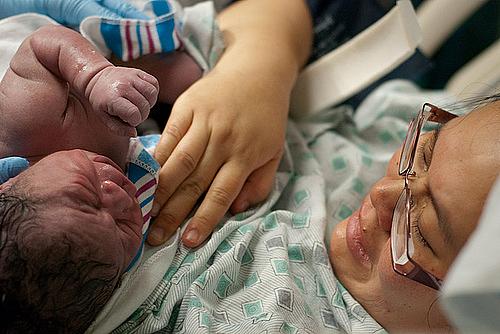C-sections may not hurt kids’ health — but we still perform way too many

You may have seen some of the headlines earlier this week in response to a new study in the journal Pediatrics on cesarean or C-section births.
“Study: Cesarean delivery won't harm children's health” announced the Healthday story carried by CBS News and The Chicago Tribune.
The study of more than 5,000 Australian children that prompted the coverage “found few differences between children delivered by cesarean delivery and those born vaginally.” As the journal notes, that’s in contrast to earlier studies that found associations between C-section deliveries and child health problems such as asthma and obesity. (Those studies didn’t control as well for confounding factors, the study’s authors suggest.)
While the new research clearly isn’t a brief in support of C-sections — it’s agnostic on the larger issue of the procedure’s prevalence — you could be forgiven for feeling a touch of whiplash from the previous week, in which media outlets across the country localized findings from the new 2015 Leapfrog Hospital Survey. The employer-backed group found that “over 60% of reporting hospitals had excessive rates of C-sections.”
According to the Leapfrog survey, average C-section rates ranged from a low of about 18 percent of births in Utah to a high of 35 percent in Kentucky. (The World Health Organization describes the ideal C-section rate as between 10 and 15 percent, while Leapfrog offers a highly specific target rate of 23.9 percent or lower.)
While Leapfrog’s new C-section data are based on responses from 1,122 hospitals across the country, it’s worth noting that many hospitals didn’t respond. “In Oklahoma, specifically, we asked 70 hospitals to respond to this survey, and only six of them responded,” Leapfrog’s Jillian Laffrey told KFOR in Oklahoma City. “That's just not enough.”
Even so, it’s been well known for years now that the United States has a problem with unnecessarily high C-section rates. In 2013, cesarean deliveries made up nearly 33 percent of all births. In 1996, that figure was just under 21 percent.
In light of this latest Pediatrics study that would seem to cast doubt on links to cesarean-related child health problems, it’s fair to ask why we should care.
There are a couple reasons. First, C-sections pose greater risks for mothers, including wound infection, blood clots, a longer recovery from childbirth and a greater chance of complications during future pregnancies. The risk of these severe complications is about three times greater for C-sections, compared with vaginal deliveries.
The risk of a mother dying goes up as well, with 13.3 out of 100,000 women dying during or after Cesarean births, compared with 3.6 out of 100,000 women who deliver vaginally, according to a consensus statement from the American College of Obstetricians and Gynecologists and the Society for Maternal-Fetal Medicine last year.
Second, C-sections are considerably more expensive than traditional deliveries. Commercial insurers pay about 60 percent more on average for C-sections, according to the California Maternal Quality Care Collaborative. The Pacific Business Group on Health has estimated that unnecessary Cesarean deliveries “cost public and private payers in California at least $240 million in 2011 alone.”
If part of the goal of health reform in the United States is to lower overall spending by curbing unnecessary or “wasteful” procedures, then C-sections remain a natural target. Surveys like the one released by Leapfrog last week help put a spotlight on hospitals and providers who overuse the procedure, perhaps because of financial incentives or convenience.
As I’ve written before, big employers can wield strong influence on hospitals whose C-section rates are alarmingly high, especially when they threaten to take their business elsewhere. In response to employer pressure, Hoag Memorial Hospital Presbyterian in Orange County, California, quickly brought down its C-section rate from about 38 percent in 2012 to less than 25 percent three years later.
The threat of a financial hit speaks louder than “target rates” and “consensus statements” when it comes to bringing down C-section rates. But it will likely take more large employers and their plans asking tough questions before the majority of hospitals reevaluate how they’re delivering babies.
Related posts
In efforts to curtail rising C-section rates, data prove key
[Photo by Mamma Loves via Flickr.]

